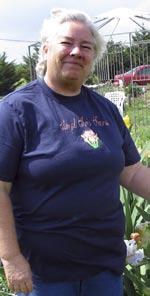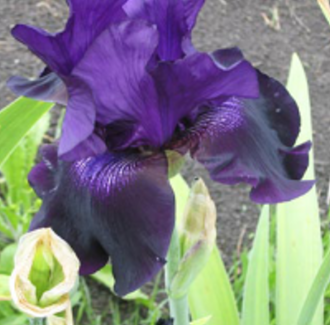This article appeared in the Spring 2008 issue of Texoma Living!.
They are yellow, pink, blue, orange, purple, white— even black. They dance in the wind like fairies, their arms over their heads, the breezes blowing their ruffled gossamer dresses— the most beautiful of all flowers, the iris.
When the Dallas Iris Society takes its annual bus tour on April 27, one of their stops will be Angel Iris Farm on Luella Road in Sherman. At the top of a hill on this winding country road, near the intersection of Harrell and Luella, the land levels out, and there, on small, flat hilltop, Don and Janice Thompson live and work an acre of registered, bearded irises.
Irises are fascinating flowers. They reach back to Egyptian times where their rhizomes (underground tubers) were valued for medicines and perfumes. Today, our fascination with these easy-to-grow beauties comes from their flower, whose name comes from the Greek word for rainbow.
Rainbows they are. Irises span the spectrum in color, freely mixing and matching tops and bottoms like ladies in a Beverly Hills boutique. When an iris-lover discovers that irises can cross-pollinate to create new colors and mixes, the fascination deepens. That is what captured Janice and Don Thompson’s imagination.
Janice Thompson looks a bit like a fairy godmother, or a friendly lunchroom lady, which indeed she is. She smiles as she shows off her favorite heirlooms and her iris Hoptoit, a silvery white that won the best space-age category in 2007 at the Texoma Rainbow Iris Society show. If you visit her in late afternoons or on weekends, she will walk with you through her display gardens, where she is experimenting with hybridizing new varieties and growing other species besides the bearded one that is most common.
When the Thompsons came to this land, they had no idea of creating an iris farm. They were bird fanciers, collecting and showing English parakeets. They grew irises, but only on the side. When Janice learned that the same ease of breeding that facilitated the development of new irises threatened lovely, old cultivars, her interest in the flowers took on a more serious bent.
She joined the Hips (Historic Iris Preservation Society) and the Texoma Rainbow Iris Society, where she has served many years in leadership positions, including three years as president. She began collecting heritage irises (at least 30 years old). By summer of 2003, when locally-famous isisarians Ira and Thelma Inman put up their collection for sale, Janice and Don already had more than 40 historic irises.
The Inmans had carefully tended and harvested their irises for many years. Thelma’s records were meticulous and her stock strong. Janice and Don knew they had the perfect field for a commercial farm behind their house, and with it, Janice could have a show place for her antique irises. She could breed new varieties and register them.
There were expenses: the initial outlay for Mrs. Inmans’s rhizomes, as well as tags, fertilizer, weed killer and in dry years, water. And labor: tilling, planting, marketing, bookkeeping, redigging every three or four years.
Nevertheless, the Thompsons took the plunge. They sold their birds and bought the flowers, personally digging and replanting each one.
Today Janice is waiting for her state certification for nursery and agricultural products. With that in hand, she can register iris varieties that she creates. The creations must have their family trees documented as carefully as those of thoroughbred horses.
“You take pollen from one, such as Trillionaire.” Janice held the bright yellow flower in her hand. “And brush it over the stamen of another, such as Freedom Flight (white) and allow the seed pod to mature. It takes two to three years to flower, and each seed may produce a different flower.”

Janice is trying to hybridize a heritage variety, Butterfly Baby, a lovely white with blue stripes, with space age, variegatedleafed, yellow Moonbear. She has no idea what sort of flowers will appear. Instead of emerging in an exquisite, striped yellow and blue that would take one’s breath away, the flowers may come out a mud-colored army green.
Some hybrids pick up weaknesses such as fragile stems and a susceptibility to diseases, but if a grower is careful and uses sturdy stock, many times something great happens. Then, breeders plant rhizomes from chosen plants and allow them to multiply until they have produced enough rhizomes to send to iris judges everywhere. The judges test them for stability. The entire process may easily take more than 10 years. No wonder a new variety is a cause for celebration.
Janice and Don currently have over 700 different varieties. One hundred thirty of these have earned registration as historic. They hope that someday their beautiful dancing angels will bring them a profit, and maybe they can quit their day jobs.
That is why the Angel Iris Farm sign reads “Visitors Welcome.” During April and May when the irises are blooming, visitors can walk through the field and write down the names of the dancing angels they would like to buy. There is a tag on each variety: gold tags for historic and black for newer ones. Visitors can see exactly what the size and color are, and Janice can tell how sturdy a plant is, when it will bloom, and where it came from. Then in late summer, she will dig them and clean them. By September, the rhizomes will be ready to purchase, just in time for fall planting.
If you plan to visit in April and May, you need to come after 2:00 pm or on weekends. Janice can be reached at 903-774-6785.
For more information and lots of pictures, visit the Angel Iris Farm website at http://lonestar.50megs.com/iris, or e-mail at ciris03@yahoo.com.
Iris Facts
Most bearded historic irises come from the efforts of two brothers, Hans and Jacob Sass. Born in Germany in 1868 and 1872, they migrated with their parents to Nebraska in 1884. Each of them worked lifelong at developing many new kinds of flowers, including irises. They died in 1949 and 1946 respectively, therefore any historic iris originally bred, named and registered by the brothers is more than 50 years old. Irises are technically herbs as they are valued for qualities such as medicinal properties, flavor and scent, and very versatile. Many live in desert conditions, going dormant in the summer. Others live in water. They grow from both rhizomes and bulbs. Today the rhizomes are used in orris root and perfumes. Some hybridizers are working hard to produce a true red. There are beautiful flaming coppers and dark terra cottas, which show they are getting closer.
How to Talk Irises
Beard – Thick bushy hairs on the upper part of each of the three lower petals (falls).
Branch – Lateral extension of the main bloom stem that produces additional flowers.
Flare – Fall having an outward horizontal curve.
Falls – Three downward curving lower petals (sepals) of the flower.
Form – Structure or position of the petals that determines a flower’s overall shape.
Horns – Long pointed growths protruding upward from the ends of the beards.
Haft – The upper part of falls that connects to rest of flower; shoulders next to beards.
Increase – New fans growing from the side of therhizome.
Lace – Very frilled or crimped serrations on the outer edges of the petals.
Rhizome – Thick bulb-like underground stem having roots and leaves.
Ruffles – Bouncy, wavy, or rolling form applied to the petals.
Signal – A spot pattern of different color on the falls just below the beard.
Spath – Leaf-like covering over the base of the flower (ovary).


I want to buy Iris bulbs for my daughter-in-law to plant this coming sept. or Oct. Can you tell me who sells iris bulbs in Grayson County? I live in Carrollton in Dallas County but come up to Sherman often.Thank you,
Donna